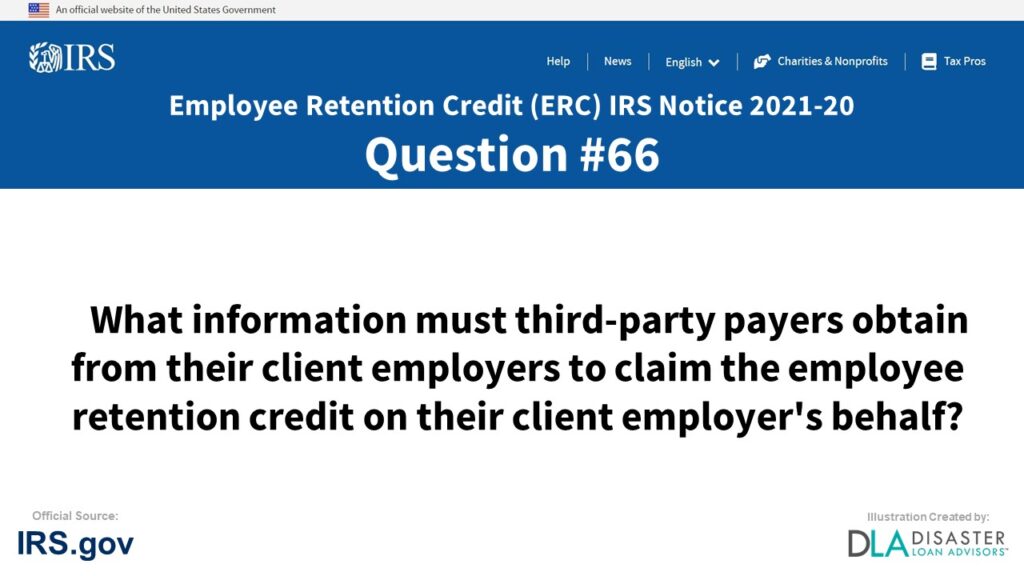
Question #66:
What information must third-party payers obtain from their client employers to claim the employee retention credit on their client employer’s behalf?
Found under the M. Special Issues for Employers: Use of Third-Party Payers section of the Employee Retention Credit (ERC) IRS Notice 2021-20 with updated guidance to help business owners follow the current ERC rules.
The answer to question #66, What information must third-party payers obtain from their client employers to claim the employee retention credit on their client employer’s behalf?, can be found below.
ERC IRS Notice 2021-20 Question #66:
M. Special Issues for Employers: Use of Third-Party Payers
What information must third-party payers obtain from their client employers to claim the employee retention credit on their client employer’s behalf?
If a third-party payer (such as a CPEO, PEO, or other section 3504 agent) is claiming the employee retention credit on behalf of the client employer, it must collect from the client employer any information necessary to accurately claim the employee retention credit on its client employer’s behalf. This includes obtaining information with respect to the client employer’s claims for credits under sections 7001 and 7003 of the FFCRA and under section 45S of the Code, as well as whether the client employer has received a Paycheck Protection Program loan authorized under the CARES Act.
For more information about the Employee Retention Credit (ERC) IRS Notice 2021-20, visit the Internal Revenue Service (IRS) Department of the Treasury, official IRS.gov tax website.
Conclusion and Summary on What information must third-party payers obtain from their client employers to claim the employee retention credit on their client employer’s behalf? – #66 ERC IRS Notice 2021-20
The answer to Question #66: “What information must third-party payers obtain from their client employers to claim the employee retention credit on their client employer’s behalf?” was answered in detail above. It was found under section “M. Special Issues for Employers: Use of Third-Party Payers” in IRS Notice 2021-20.
Leave a comment below if you have further questions on the Employee Retention Credit (ERC) or for clarifications on What information must third-party payers obtain from their client employers to claim the employee retention credit on their client employer’s behalf?
Employee Retention Tax Credit (ERTC): Expert Assistance to Claim Your Business ERC Credit
Up to a $26,000 ERC Refund from the IRS for Each Employee
Disaster Loan Advisors can assist your business with the complex and confusing Employee Retention Credit (ERC), Form 941-X, and the Employee Retention Tax Credit (ERTC) program.
Depending on eligibility, business owners and companies can receive up to $26,000 per employee based on the number of W2 employees you had on the payroll in 2020 and 2021.
The ERC / ERTC Tax Credit Program is a valuable IRS tax credit you can claim. This is money you have already paid to the IRS in payroll taxes for your W2 employees.
We DO NOT charge a percentage (%) of your ERC Refund like some companies are charging. Some ERC firms out there are charging upwards of 15% to 35% of your ERC refund!
Our professional ERC fee and pricing structure is very reasonable in comparison.
If you are looking for an ERC Company that believes in providing professional ERC Services and value, in exchange for a fair, reasonable, and ethical fee for the amount of work required, Disaster Loan Advisors is a good fit for you.
Schedule Your Free Employee Retention Credit Consultation to see what amount of employee retention tax credit your company qualifies for.
Cover Image Credit: Irs.gov / IRS Notice 2021-20 / Disaster Loan Advisors.
